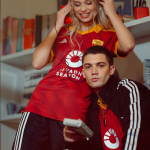
The role of Lacoste in football
Did you know that the crocodile has made jerseys for Rome and Lazio?
April 11th, 2024
When we think of Lacoste, our minds immediately go to the polo shirts with the iconic crocodile logo. A legend that began through sports, but soon became an icon of lifestyle clothing. In addition to golf, the only other sport where Lacoste is at home is tennis. This is a natural combination, given that its founder René Lacoste was once considered the best tennis player of his generation and created a uniform that expressed the noble and aristocratic origins through the elegance of the polo shirts with two buttons. The tennis heritage of Lacoste continued throughout the 20th century and up to the present day, as shown by the sponsorship between Lacoste and Novak Djokovic, who has been a brand ambassador since 2017. The Serbian, after leaving UNIQLO, brought the crocodile back to the top of the ATP ranking, becoming the first male tennis player to win 23 Grand Slams in his career with his victory at the 2023 Roland Garros tournament. This achievement was made while wearing an orange shirt with a green crocodile logo.
It is more difficult to place Lacoste in the world of football. The French company has never been associated with any major international club in recent times, nor has it followed the trend of other fashion and sportswear brands by choosing football players as ambassadors to capitalize on their popularity. However, Lacoste's presence in the world of football is not nonexistent. We have to go back to the 1960s when Lacoste polo shirts became the official uniforms for Roma, Lazio, and Benfica in Portugal a few years later. It was a time when there wasn't much variety in football jersey designs, so the polo shirts worn by players on the field were not much different from those worn by doctors and lawyers in their daily lives: two-button closure, stiff collar, and slightly tighter sleeve trim with rougher finishing compared to the fabric of the shirt. The only major difference compared to today is that the crocodile logo, in some cases, did not appear on the left side of the chest but only on the label inside the shirt.
Interestingly, both Lazio and Roma, who both wore shirts from the same sponsor, even though it wasn't visible, had their traditional team colors altered to match the color availability of the French company. So when Lazio wore Lacoste polo shirts through the official supplier "La bottega dello sport" of Uber Gradella, the shirts were not in the classic light blue that characterized the club's jerseys, but rather in a darker shade of blue. Similarly, AS Roma did not use their usual Pompeian red but a brighter shade of red, as they had to choose from the four colors that Lacoste produced until 1964. The numbers on the shirts were made of panno lenci, a type of felt fabric hand-cut and sewn onto the back of the polo shirts.
Those were different times, and today, polo shirts are no longer used for performance purposes, but some characteristics remain. It is still common to see a double-button closure, an elegant solution adopted, for example, by adidas for the 2022/23 season for the home jerseys of Arsenal, Real Madrid, and Manchester United, for the Toni Kroos dismay. However, the full polo shirt design has been completely abandoned or almost abandoned. There are certainly examples: in the 2016/17 and 2018/19 seasons, Le Coq Sportif created for Fiorentina an elegant jersey with a two-button closure and a thin line of fabric in a darker shade of purple used for the collar. But beyond isolated cases, there has never been a real trend. More often, brands resort to this solution when they feel the need to offer a more traditional and elegant option. It's hard to blame them, as both clubs and brands are trying to attract a younger and more demanding audience through increasingly modern and innovative jerseys. Polo shirts go in the opposite direction, they are a symbol of an elegance that belongs to the past but still have something to say.

















